




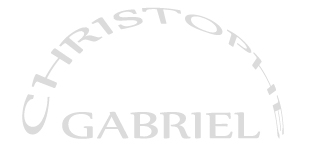
 |
 |
 |
 |

|
 |
 |
 |
 |
 |
 |
 |
 |
 |
 |
 |
 |
 |
|
|
Atelier51 Christophe GABRIEL |
 |
|
CONTACT: Atelier 51 17 rue du Javelot 75013 Paris 01 45 85 77 77 06 19 30 59 92 contact@atelier-cg.com |
|||
Liens :
|
|||
| Mots clefs: Peinture-murale,
décoration, fresque, fresques, décors, décor, mural, art mural,
décoration, panoramique, panoramiques, décoration murale, peinture sur
mur |
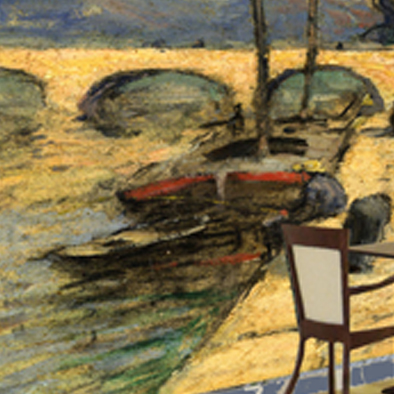 |
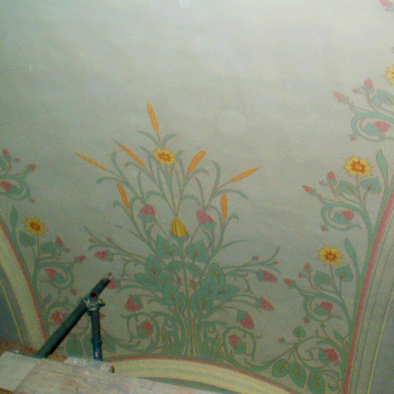 |
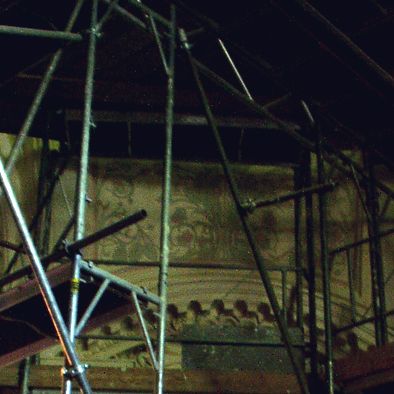 |
|
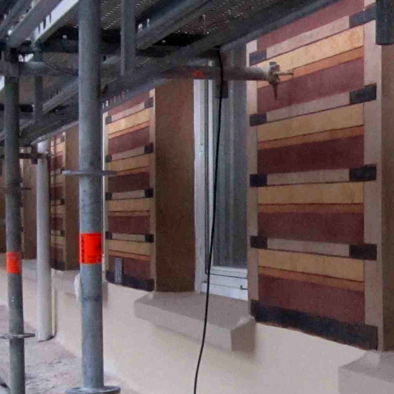 |
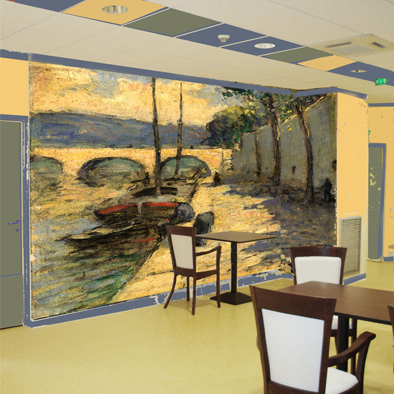 |
 |
|
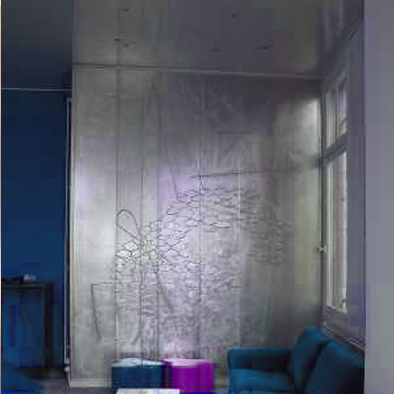 |
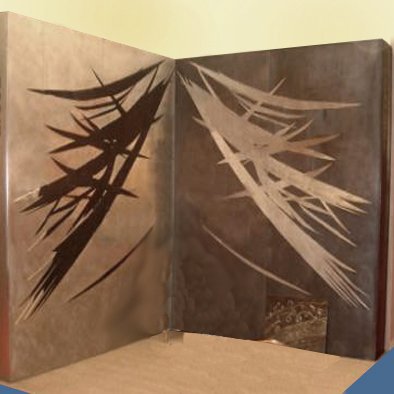 |
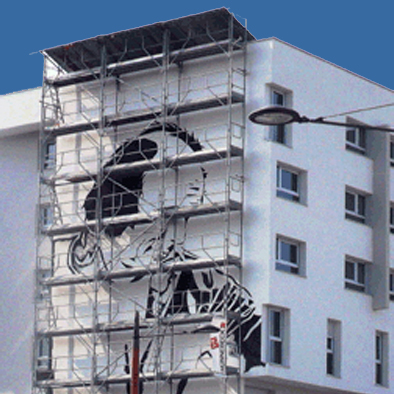 |
|
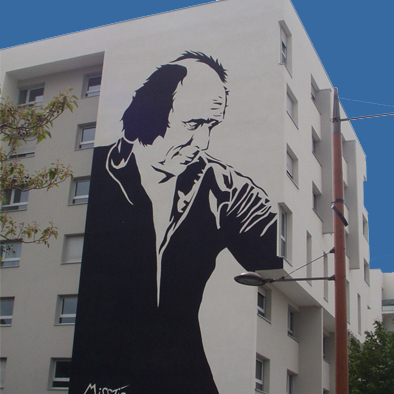 |
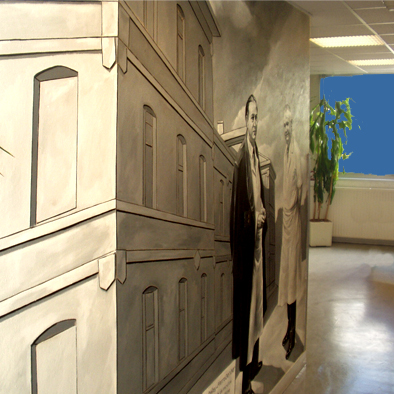 |
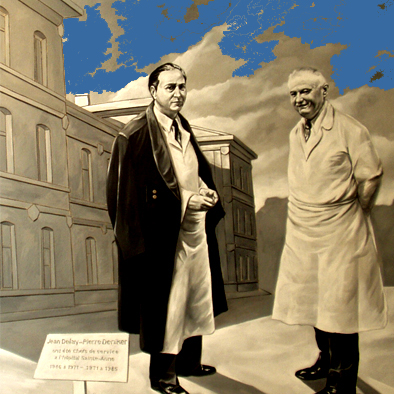 |
 |
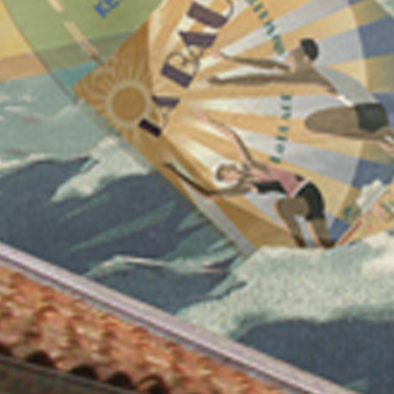 |
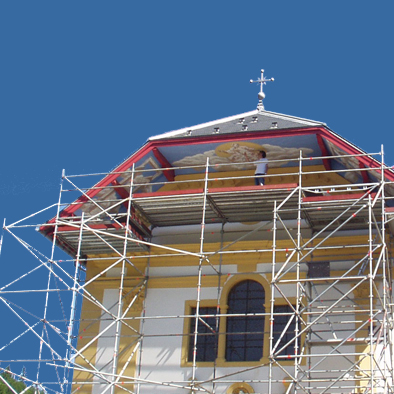 |
|
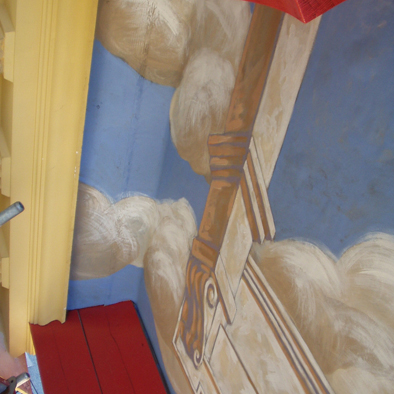 |
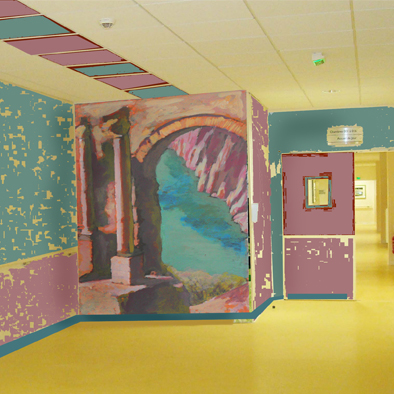 |
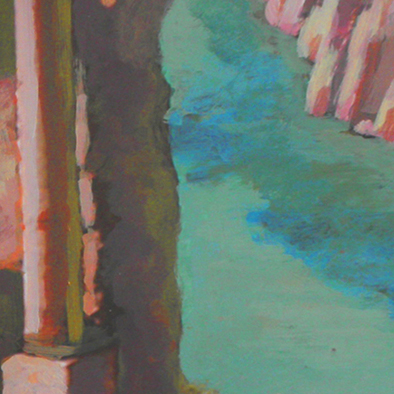 |
|
Fresco (plural either frescos or frescoes) is any of several related mural painting types, done on plaster on walls or ceilings. The word fresco comes from the Italian word affresco [afˈfresːko] which derives from the Latin word for "fresh". Frescoes were often made during the Renaissance and other early time periods.
Buon fresco technique consists of painting in pigment mixed with water on a thin layer of wet, fresh, lime mortar or plaster, for which the Italian word for plaster, intonaco, is used. Because of the chemical makeup of the plaster, a binder is not required, as the pigment mixed solely with the water will sink into the intonaco, which itself becomes the medium holding the pigment. The pigment is absorbed by the wet plaster; after a number of hours, the plaster dries and reacts with the air: it is this chemical reaction which fixes the pigment particles in the plaster. One of the first painters in the post-classical period to use this technique was the Isaac Master in the Upper Basilica of Saint Francis in Assisi. A person who creates fresco is called a frescoist.
A secco painting, in contrast, is done on dry plaster (secco is "dry" in Italian). The pigments thus require a binding medium, such as egg (tempera), glue or oil to attach the pigment to the wall. It is important to distinguish between a secco work done on top of buon fresco, which according to most authorities was in fact standard from the Middle Ages onwards, and work done entirely a secco on a blank wall. Generally, buon fresco works are more durable than any a secco work added on top of them, because a secco work lasts better with a roughened plaster surface, whilst true fresco should have a smooth one. The additional a secco work would be done to make changes, and sometimes to add small details, but also because not all colours can be achieved in true fresco, because only some pigments work chemically in the very alkaline environment of fresh lime-based plaster. Blue was a particular problem, and skies and blue robes were often added a secco, as neither azurite blue, nor lapis lazuli, the only two blue pigments then available, work well in wet fresco.[1]
It has also become increasingly clear, thanks to modern analytical techniques, that even in the early Italian Renaissance painters quite frequently employed a secco techniques so as to allow the use of a broader range of pigments. In most early examples this work has now entirely vanished, but a whole fresco done a secco on a surface roughened to give a key for the paint may survive very well, although damp is more threatening to it than to buon fresco.
A third type, called mezzo-fresco, is painted on nearly-dry intonaco—firm enough not to take a thumb-print, says the sixteenth-century author Ignazio Pozzo—so that the pigment only penetrates slightly into the plaster. By the end of the sixteenth century this had largely displaced buon fresco, and was used by painters such as Gianbattista Tiepolo or Michelangelo. This technique had, in reduced form, the advantages of a secco work.
The three key advantages of work done entirely a secco were that it was quicker, mistakes could be corrected, and the colours varied less from when applied to when fully dry—in wet fresco there was a considerable change.
In painting buon fresco, a rough underlayer called the arriccio is added to the whole area to be painted, and allowed it to dry for some days. Many artists sketched their compositions on this underlayer, which would never be seen, in a red pigment called sinopia; these drawings are also called sinopia. Later,[when?] techniques for transferring paper drawings to the wall were developed. The main lines of the drawing were pricked over with a point, held against the wall, and a bag of soot (spolvero) banged on them on produce black dots along the lines. If a previous fresco was being painted over, the surface would be roughened to give a key. On the day of painting, a thinner, smooth layer of fine plaster, the intonaco, is added to the amount of wall that can be expected to be completed in a day, sometimes matching the contours of the figures or the landscape, but more often just starting from the top of the composition. This area is called the giornata ("day's work"), and the different day stages can usually be seen in a large fresco, by a sort of seam that separates one from the next.
Buon frescoes are difficult to create because of the deadline associated with the drying plaster. Generally, a layer of plaster will require ten to twelve hours to dry; ideally, an artist would begin to paint after one hour and continue until two hours before the drying time—giving seven to nine hours working time. Once a giornata is dried, no more buon fresco can be done, and the unpainted intonaco must be removed with a tool before starting again the next day. If mistakes have been made, it may also be necessary to remove the whole intonaco for that area—or to change them later à secco.
In a wall-sized fresco, there may be ten to twenty or even more giornate, or separate areas of plaster. After centuries, these giornate (originally, nearly invisible) have sometimes become visible, and in many large-scale frescoes, these divisions may be seen from the ground. Additionally, the border between giornate was often covered by à secco painting, which has since fallen off.
For wholly à secco work, the intonaco is laid with a rougher finish, allowed to dry completely and then usually given a key by rubbing with sand. The painter then proceeds much as he would on a canvas or wood panel.
The earliest known examples frescoes done in the Buon Fresco method date at around 1500 BC and are to be found on the island of Crete in Greece. The most famous of these, The Toreador, depicts a sacred ceremony in which individuals jump over the backs of large bulls. While some similar frescoes have been found in other locations around the Mediterranean basin, particularly in Egypt and Morocco, their origins are subject to speculation.
Some art historians believe that fresco artists from Crete may have been sent to various locations as part of a trade exchange, a possibility which raises to the fore the importance of this art form within the society of the times. The most common form of fresco was Egyptian wall paintings in tombs, usually using the a secco technique.
Frescoes were also painted in ancient Greece, but few of these works have survived. In southern Italy, at Paestum, which was a Greek colony of the Magna Graecia, a tomb containing frescoes dating back to 470 BC, the so called Tomb of the Diver was discovered on June 1968. These frescoes depict scenes of the life and society of ancient Greece, and constitute valuable historical testimonials. One shows a group of men reclining at a symposium while another shows a young man diving into the sea.
Roman wall paintings, such as those at the magnificent Villa dei Misteri (1st century B.C.) in the ruins of Pompeii, and others at Herculaneum, were completed in buon fresco.
Late Roman Empire (Christian) 1st-2nd century frescoes were found in catacombs beneath Rome and Byzantine Icons were also found in Cyprus, Crete, Ephesus, Cappadocia and Antioch. Roman frescoes were done by the artist painting the artwork on the still damp plaster of the wall, so that the painting is part of the wall, actually colored plaster.
Also a historical collection of Ancient Christian frescoes can be found in the Churches of Goreme Turkey.
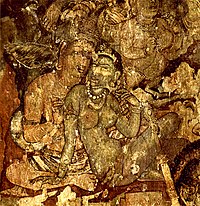
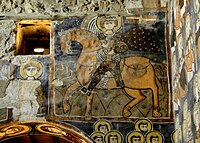
Thanks to large number of ancient rock-cut cave temples there have been preserved valuable ancient and early medieval frescoes in more than 20 locations of India.[2]
The frescoes on the ceilings and walls of the Ajanta Caves were painted between c. 200 BC and 600 and are the oldest known frescoes in India. They depict the Jataka tales that are stories of the Buddha's life in former existences as Bodhisattva. The narrative episodes are depicted one after another although not in a linear order. Their identification has been a core area of research on the subject since the time of the site's rediscovery in 1819. Other locations with valuable preserved ancient and early medieval frescoes include Bagh Caves, Ellora Caves, Sittanavasal, Armamalai Cave, Badami Cave Temples and other locations. Frescoes have been made in several techniques including tempera technique.
The later Chola paintings were discovered in 1931 within the circumambulatory passage of the Brihadisvara Temple in India and are the first Chola specimens discovered.
Researchers have discovered the technique used in these frescos. A smooth batter of limestone mixture is applied over the stones, which took two to three days to set. Within that short span, such large paintings were painted with natural organic pigments. Totez.
During the Nayak period the chola paintings were painted over. The Chola frescos lying underneath have an ardent spirit of saivism is expressed in them. They probably synchronised with the completion of the temple by Rajaraja Cholan the Great.
Frescoes also can be found in Sigiriya, situated in the central Matale District of Sri Lanka) ,[3] which are reminiscent of the Ajanta Caves of India. The frescoes were created in the 5-6th centuries. They are considered a masterpiece of ancient frescoes.
The late Medieval period and the Renaissance saw the most prominent use of fresco, particularly in Italy, where most churches and many government buildings still feature fresco decoration. In Denmark too, church wall paintings or kalkmalerier were widely used in the Middle Ages (first Romanesque then Gothic) and can be seen in some 600 Danish churches as well as in churches in the south of Sweden which was Danish at the time.[4]
One of the rare examples of Islamic fresco painting can be seen in Qasr Amra, the desert palace of the Umayyads in the 8th century. Magotez.
Northern Romania boasts about a dozen painted monasteries, completely covered with frescos inside and out, that date from the second quarter of the sixteenth century. The most remarkable are the monastic foundations at Humor (hoo mor), Moldoviţa (mol do vee' tsa), Arbore (are' bo ray) and Voroneţ (vo ro nets). Suceviţa (sue che vee' tsa), dating from 1600, represents a late return to the style developed some seventy years earlier. The tradition of painted churches continued into the nineteenth century in other parts of Romania, although never to the same extent.[5]
Andrea Palladio, the famous Italian architect of the 16th century, built many mansions with plain exteriors and stunning interiors filled with frescoes.
The Foujita chapel in Reims completed in 1966, is an example of modern frescos, the interior being painted with religious scenes by the School of Paris painter Tsuguharu Foujita. In 1996, it was designated an historic monument by the French Government.
Jose Clemente Orozco, Fernando Leal, David Siqueiros and Diego Rivera the famous Mexican artists renewed the art of fresco painting in the 20th century. Orozco, Siqueiros, Rivera and his wife Frida Kahlo contributed more to the history of Mexican fine arts and to the reputation of Mexican art in general than anybody else. Together with works by Orozco, Siqueiros, and others, Fernando Leal and Rivera's large wall works in fresco established the art movement known as Mexican Muralism. Among contemporary artists, Fernando Leal Audirac has developed a technique of transportable frescos. Totez.
Italian Early Medieval
Italian Late Medieval-Quattrocento
Italian "High Renaissance"
Italian Baroque
Czech Republic
Mexico
Serbian Medieval
The climate and environment of Venice has proved to be a problem for frescoes and other works of art in the city for centuries. The city is built on a lagoon in northern Italy. The humidity and the rise of water over the centuries have created a phenomenon known as rising damp. As the lagoon water rises and seeps into the foundation of a building, the water is absorbed and rises up through the walls often causing damage to frescoes. Venetians have become quite adept in the conservation methods of frescoes.
The following is the process that was used when rescuing frescos in La Fenice, a Venetian opera house, but it is the same process for similarly damaged frescoes. First, a protection and support bandage of cotton gauze and polyvinyl alcohol is applied. Difficult sections are removed with soft brushes and localized vacuuming. The other areas that are easier to remove (because they had been damaged by less water) are removed with a paper pulp compress saturated with bicarbonate of ammonia solutions and removed with deionized water. These sections are strengthened and reattached then cleansed with base exchange resin compresses and the wall and pictorial layer were strengthened with barium hydrate. The cracks and detachments are stopped with lime putty and injected with an epoxy resin loaded with micronized silica.[7]
| [关闭] |
濕壁畫,原意是“新鮮”,是一種十分耐久的壁飾繪畫,泛指在鋪上灰泥的牆壁及天花板上繪畫的畫作,通常是先將研磨好的乾粉顏料摻入清水,製成水性顏料,再將顏料塗在剛抹在牆壁表面的濕灰泥,再等待灰泥乾燥凝固之後,便永久保存於牆 壁表面。
Фреска е слика добиена со традиционална постапка на сликање со директно нанесување на бојата на свеж малтер. Фрескисликарството е најстара техника во сликарството која датира од праисторијата. Името и усовршувањето на техниката, доаѓа од времето на италијанската ренесанса.
A mural is any piece of artwork painted directly on a wall, ceiling or other large permanent surface] History
Murals of sorts date to Upper Paleolithic times such as the paintings in the Chauvet Cave in Ardèche department of southern France (around 30.000 BC). Many ancient murals have survived in Egyptian tombs (around 3150 BC),[1] the Minoan palaces (Middle period III of the Neopalatial period, 1700-1600 BC) and in Pompeii (around 100 BC - AD 79).
In modern times the term became more well-known with the Mexican "muralista" art movement (Diego Rivera, David Siqueiros, or José Orozco). There are many different styles and techniques. The best-known is probably fresco, which uses water-soluble paints with a damp lime wash, a rapid use of the resulting mixture over a large surface, and often in parts (but with a sense of the whole). The colors lighten as they dry. The marouflage method has also been used for millennia.
Murals today are painted in a variety of ways, using oil or water-based media. The styles can vary from abstract to trompe-l'œil (a French term for "fool" or "trick the eye"). Initiated by the works of mural artists like Graham Rust or Rainer Maria Latzke in the 1980s, trompe-l'oeil painting has experienced a renaissance in private and public buildings in Europe. Today, the beauty of a wall mural has become much more widely available with a technique whereby a painting or photographic image is transferred to poster paper or canvas which is then pasted to a wall surface (see wallpaper, Frescography) to give the effect of either a hand-painted mural or realistic scene.
In the history of mural several methods have been used:
A Fresco painting, from the Italian word affresco which derives from the adjective fresco ("fresh"), describes a method, where the paint is applied on plaster on walls or ceilings. The Buon fresco technique consists of painting in pigment mixed with water on a thin layer of wet, fresh, lime mortar or plaster. The pigment is then absorbed by the wet plaster; after a number of hours, the plaster dries and reacts with the air: it is this chemical reaction which fixes the pigment particles in the plaster. After this the painting stays for a long time up to centuries in fresh and brilliant colors.
"A Secco" painting is done on dry plaster (secco is "dry" in Italian). The pigments thus require a binding medium, such as egg (tempera), glue or oil to attach the pigment to the wall.
"Mezzo-fresco", is painted on nearly-dry plaster, which is defined by the sixteenth-century author Ignazio Pozzo as “firm enough not to take a thumb-print”, so that the pigment only penetrates slightly into the plaster. By the end of the sixteenth century this had largely displaced the buon fresco method, and was used by painters such as Gianbattista Tiepolo or Michelangelo. This technique had, in reduced form, the advantages of a secco work.
In Greco-Roman times mostly encaustic colors ground in a molten beeswax or resin binder and applied in a hot state was used.
Tempera painting is one of the oldest known methods in mural painting, In tempera the pigments are bind an albuminous medium such as egg yolk or egg white and have been diluted in water.
In 16th-century Europe, oil painting on canvas came up as an easier method for mural painting. The advantage was, that the artwork could be completed in the artist’s studio and later transported to its destination and there attached to the wall or ceiling. Oil paint can be said to be the least satisfactory medium for murals, because of its lack of brilliance in colour. Also the pigments are yellowed by the binder or are easier affected by atmospheric conditions. The canvas itself is more subject to rapid deterioration then a plaster underground.
Different muralists tend to become experts in their preferred medium and application, whether that be oil paints, emulsion or acrylic paints applied by brush, roller or airbrush/aerosols. Clients will often ask for a particular style and the artist may adjust to the appropriate technique.
A consultation usually leads to a detailed design and layout of the proposed mural with a price quote that the client approves before the muralist starts on the work. The area to be painted can be gridded to match the design allowing the image to be scaled accurately step by step. In some cases the design is projected straight onto the wall and traced with pencil before painting begins. Some muralists will paint directly without any prior sketching, preferring the spontaneous technique.
Once completed the mural can be given coats of varnish or protective acrylic glaze to protect the work from UV rays and surface damage.
As an alternative to a hand-painted or airbrushed mural, digitally printed murals can also be applied to surfaces. Already existing murals can be photographed and then be reproduced in near-to-original quality.
The disadvantages of pre-fabricated murals and decals are that they are often mass produced and lack the allure and exclusivity of an original artwork. They are often not fitted to the individual wall sizes of the client and their personal ideas or wishes can not be added to the mural as it progresses. The Frescography technique, a digital manufacturing method (CAM) invented by Rainer Maria Latzke addresses some of the personalisation and size restrictions.
Digital techniques are commonly used in advertisements. A "wallscape" is a large advertisement on or attached to the outside wall of a building. Wallscapes can be painted directly on the wall as a mural, or printed on vinyl and securely attached to the wall in the manner of a billboard. Although not strictly classed as murals, large scale printed media are often referred to as such. Advertising murals were traditionally painted onto buildings and shops by sign-writers, later as large scale poster billboards.
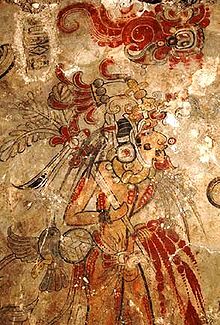
Murals are important in that they bring art into the public sphere. Due to the size, cost, and work involved in creating a mural, muralists must often be commissioned by a sponsor. Often it is the local government or a business, but many murals have been paid for with grants of patronage. For artists, their work gets a wide audience who otherwise might not set foot in an art gallery. A city benefits by the beauty of a work of art.
Murals can be a relatively effective tool of social emancipation or achieving a political goal. Murals have sometimes been created against the law, or have been commissioned by local bars and coffeeshops. Often, the visual effects are an enticement to attract public attention to social issues. State-sponsored public art expressions, particularly murals, are often used by totalitarian regimes as a tool of mass-control and propaganda. However, despite the propagandist character of that works, some of them still have an artistic value.
Murals can have a dramatic impact whether consciously or subconsciously on the attitudes of passers by, when they are added to areas where people live and work. It can also be argued that the presence of large, public murals can add aesthetic improvement to the daily lives of residents.
World-famous murals can be found in Mexico, New York, Philadelphia, Belfast, Derry, Los Angeles, Nicaragua, Cuba and in India. [1] They have functioned as an important means of communication for members of socially, ethnically and racially divided communities in times of conflict. They also proved to be an effective tool in establishing a dialogue and hence solving the cleavage in the long run. The Indian state Kerala has exclusive murals. These Kerala mural painting are on walls of Hindu temples. They can be dated from 9th century AD.
The San Bartolo murals of the Maya civilization in Guatemala, are the oldest example of this art in Mesoamerica and are dated at 300 BC.
Many rural towns have begun using murals to create tourist attractions in order to boost economic income. Colquitt, Georgia is one such town. Colquitt was chosen to host the 2010 Global Mural Conference. The town has more than twelve murals completed, and will host the Conference along with Dothan, Alabama, and Blakely, Georgia. In the summer of 2010, Colquitt will begin work on their Icon Mural.


The famous Mexican mural movement in the 1930s brought a new prominence to murals as a social and political tool. Diego Rivera, José Orozco and David Siqueiros were the most famous artists of the movement. Between 1932 and 1940, Rivera also painted murals in San Francisco, Detroit, and New York City. In 1933 he completed a famous series of twenty-seven fresco panels entitled Detroit Industry on the walls of an inner court at the Detroit Institute of Arts.[2] During the McCarthyism of the 1950s, a large sign was placed in the courtyard defending the artistic merit of the murals while attacking his politics as "detestable."
In 1948 the Colombian Government hosted the IX Pan-American Conference to establish the Marshall plan for the Americas. The director of the OEA and the Colombian government commissioned Master Santiago Martinez Delgado, to paint a mural in the Colombian congress building to commemorate the event. Martinez decided to make it about the Cucuta Congress, and painted Bolivar in front of Santander, making liberals upset; so, due to the murder of Jorge Elieser Gaitan the mobs of el bogotazo tried to burn the capitol, but the Colombian Army stopped them. Years later, in the 1980s, with liberals in charge of the congress, they passed a resolution to turn the whole chamber in the Elliptic Room 90 degrees to put the main mural on the side and commissioned Alejandro Obregon to paint a non-partisan mural in the surrealist style.
Northern Ireland contains some of the most famous political murals in the world. Many murals serve as a public service announcement of a special interest, notably for political topics such as sex, sexual orientation, religion and intolerance. Almost 2,000 murals have been documented in Northern Ireland since the 1970s. (See Northern Irish murals.) A not political, but social related mural covers a wall in an old building, once a prison, at the top of a cliff in Bardiyah, in Libya. It was painted and signed by the artist on April 1942, weeks before his death on the first day of the First Battle of El Alamein. Known as the Bardia Mural, it was created by English artist, Private John Frederick Brill.[3]
In 1976 East Germany begun to erect a wall between East and West Berlin, which became famous as the Berlin Wall. While on the East Berlin side painting was not allowed, artists painted on the Western side of the Wall from the 80s until the fall of the Wall in 1989.
Many unknown but also known artists such as Thierry Noir and Keith Haring painted on the Wall, the “World's longest canvas”. The sometimes detailed artwork were often painted over within hours or days. On the Western side the Wall was not protected, so everybody could paint on the Wall. After the fall of the Berlin Wall in 1989 the Eastern side of the Wall became also a popular “canvas” for many mural and graffiti artists.


Many people like to express their individuality by commissioning an artist to paint a mural in their home, this is not an activity exclusively for owners of large houses. A mural artist is only limited by the fee and therefore the time spent on the painting; dictating the level of detail; a simple mural can be added to the smallest of walls.
Private commissions can be for dining rooms, bathrooms, living rooms or, as is often the case- children's bedrooms. A child's room can be transformed into the 'fantasy world' of a forest or racing track, encouraging imaginative play and an awareness of art.
The current trend for feature walls has increased commissions for muralists in the UK. A large hand-painted mural can be designed on a specific theme, incorporate personal images and elements and may be altered during the course of painting it. The personal interaction between client and muralist is often a unique experience for an individual not usually involved in the arts.
Public commissions of murals in schools, hospitals and retirement homes can achieve a pleasing and welcoming atmosphere in these caring institutions.[4]
In the 1980s, illusionary wall painting experienced a renaissance in private homes. The reason for this revival in interior design could, in some cases be attributed to the reduction in living space for the individual. Faux architectural features as well as natural scenery and views can have the effect of 'opening out' the walls. Densely built up areas of housing may also contribute to people's feelings of being cut off from nature in its free form. A mural commission of this sort may be an attempt by some people to re-establish a balance with nature.
Recently, graffiti and street art have played a key role in contemporary wall painting. Such graffiti/street artists as Keith Haring, Shepard Fairey, Mint&Serf, Futura 2000, Os Gemeos and Faile among others have successfully transcended their street art aesthetic beyond the walls of urban landscape and onto walls of private and corporate clients. As graffiti/street art became more main stream in the late 1990s, youth oriented brands such as Nike, Red Bull and Wieden Kennedy have turned to graffiti/street artists to decorate walls of their respective offices. This trend continued through 2000's with graffiti/street art gaining more recognition from art institutions worldwide.
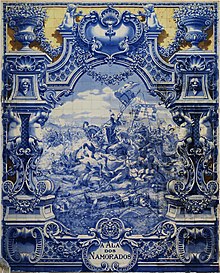
Tile murals tile paintings, which cover complete walls and give a wall painting-like impression. Tile murals are typically found in countries around the Mediterranean Sea such as Morocco, Tunisia and Arabic countries, in Portugal and Spain mostly in an often monochrom-colored form, the Azulejo.
The Azulejo (Portuguese pronunciation: [ɐzuˈleʒu], Spanish pronunciation: [aθuˈlexo]) refers to a typical form of Portuguese or Spanish painted, tin-glazed, ceramic tilework. They have become a typical aspect of Portuguese culture, manifesting without interruption during five centuries the consecutive trends in art.
Azulejos can be found inside and outside churches, palaces, ordinary houses and even train stations or subway stations. They were not only used as an ornamental art form, but also had a specific functional capacity like temperature control at homes. Many azulejos chronicle major historical and cultural aspects of Portuguese history.
Today several companies create custom tile murals using dye sublimation as well as other processes for commercial and residential spaces. Images in Tile, USA is an example of a large scale mural manufacturer.